#the song name is black sorrow from alien stage
Explore tagged Tumblr posts
Text

this song is so shadowpeach
#lego monkie kid#lmk fanart#monkie kid#shadowpeach#shadowpeach fanart#sun wukong#macaque#six eared macaque#the song name is black sorrow from alien stage#GO LISTEN TO IT NOW#doodle
625 notes
·
View notes
Text
Coping with round 7 by picturing normal au Milgram characters as Alien Stage fans. Not all of them are super into it, but have heard about it from the ones that are big fans. It's very fun to picture scenes of them discussing and getting emotional about a youtube based gradual release music video story project, 10/10 would recommend
Haruka*: Big fan of Sua, even though she makes him so sad. He's obsessed with Sweet Dream, and listens to that and My Clematis all the time.
Yuno: A tie between Ivan and Luka as her favorite character. Probably the one to get the most into the worldbuilding, knowing the minor characters and aliens' names.
Fuuta**: Is genuinely a big Till fan, but pretends he's an even bigger Till fan out of fear people will discover his huge crush on Hyuna. He went crazy over both versions of All-In.
Muu*: Likes Luka but is too afraid to sound like a fan of the antagonist, so she mostly focuses on her love of Mizi. Both because of the characters and the song itself, she really enjoys Ruler of My Heart.
Shidou: A fan of Mizi for obvious reasons, but really enjoys the melancholy of Black Sorrow and Cure
Mahiru*: Mizi all the way. She's going through it in a series about doomed romance, but she still loves it. Enjoys Mizi x Till, Hyuna x Luka, and any rarepair that passes her by.
Kazui: Yeah... Ivan... I don't think he'd be huge into the series, but if he did get deeper, I think he'd be really intrigued by Luka. Likes Black Sorrow, wasn't as into Cure as he expected.
Amane**: Has mixed feelings about the religion/love thing going on, but really likes Mizi and her songs. Really enjoys the cover songs and hearing characters sing things differently.
Mikoto: Genuinely likes the cast evenly, but if he had to pick he'd pick Till because he really enjoys the faster songs like Unknown and Blink Gone.
Kotoko: Recognizes that she's a lot like Hyuna, but Till's wildness makes him her favorite. She saw Till's death coming so she's more thrilled with Blink Gone than upset with the story
Es: Really loves Hyuna. They love the familial story with her brother and also think she's a cool character. Ivan is a close second specifically because they love his voice.
*has gotten choked up/teared up at an mv release
**has gotten choked up/teared up at an mv release and viciously denies it
#milgram#haruka sakurai#yuno kashiki#fuuta kajiyama#muu kusunoki#shidou kirisaki#mahiru shiina#kazui mukuhara#amane momose#mikoto kayano#kotoko yuzuriha#es#youre saved from my tag rant because i gotta sleep OOPS#but i wanted to jot this down before i forgor#its been bouncing around in my head since friday#please feel free to reblog with additions/corrections lol
59 notes
·
View notes
Note
For the ask game ->
3 , 8 , 13 , 21
(OMG YAY I am finally on time 😭...I have notifs on for you but I still didn't get notified so it's all based on luck if I see it or not lmao)
HIIIIIII congrats on being on time aslfjslkd you were the first ask i got :D
3: 5 songs you have been recently obsessed with?
not necessarily my favorite songs but ones ive sent in the music channel on discord recently (ignore how 3 of them are alien stage please thanks)
8: Name something you are looking forward to?
going to bed!!! im so tireddddddd
13: Favorite climate?
sunny but not too hot! & preferably not overly humid either
21: What is something you have been meaning to try?
rhythmic gymnastics cause it looks so cool and fun! will i ever actually get around to trying it? hell no but i can dream
3 notes
·
View notes
Text
Welcome~☆!
I am rwbyofmyheart, but the names you can call me are Ruby or Elle. (Obviously neither is my actual name, but they are what I will be using for this tumblr blog to protect my privacy.) I go by she/her pronouns. When I post, I will mostly be posting fanart, English lyrics for kpop/jpop songs, or anything somewhat similar. I am under 18, so I’m gonna try to keep this blog PG-13, but I will occasionally post content from Hazbin Hotel or Helluva Boss. This post has links to some of my fanart/lyrics along with some fandoms I’m in. I will try to keep it updated, but we’ll see.
Fandoms I’m in (some not as active as others, and there may be more not on the list):
RWBY (ofc)
Twisted Wonderland
Alien Stage
Ensemble Stars
Milgram
Honkai: Star Rail
Genshin Impact
Cookie Run: Kingdom
Danganronpa
Helluva Boss
Hazbin Hotel
Amazing Digital Circus
Project Sekai/Colorful Stage
Reverse: 1999
Digimon
Pokémon
Winx
Smity and Majesty
Nevermore
Cursed Princess Club
Night Owls & Summer Skies
The Four of Them
Dreamcatcher
Loona/ARTMS/Loossemble/Chuu/Yves
Everglow
Stray Kids
Twice
Itzy
Nmixx
Blackpink
(G)I-DLE
K/DA
Heartsteel
Purple Kiss
Fanart:
Whatever the heck this is
Whatever the heck this is (pt. II)
Steamboat Willie
Link
RWBY x K/DA (wip)
New Year TADC & RWBY drawings
Twisted Wonderland
OC Loading Screen Icons
Ace shitpost
Lute Fanart
Annabel Lee
English Lyrics:
Alien Stage
Ruler of My Heart
Unknown (Till the End)
Cure
Black Sorrow
Blink Gone
Dreamcatcher
Rising
We Are Young
OOTD
Reason
TWST OC Masterlist
Pokémon Shield Nuzlocke:
See side blog: @nuzlockeofmyheart (on hiatus)
Alien Stage Tumblr AU
@mizi-alnst-official
@sua-alnst-official
@till-alnst-official
@ivan-alnst-official
@luka-alnst-official
@hyuna-alnst-official
@dewey-alnst-official
@isaac-alnst-official
Other:
Realization about Bumbleby
#rwbyofmyheart#english lyrics#fanart#masterlist#kpop english lyrics#rwbyofmyheart english lyrics#rwby#k/da#dreamcatcher#disney twst#twst#twisted wonderland#shitposts#alien stage#vivinos#vivinos alien stage#alnst#greenlight volume 10#alien stage tumblr au
11 notes
·
View notes
Text
Pick a random character out of random characters I like. It can be based on design, vibes, popularity, how shakeable they are, whatever.
You could also pick a random character without looking and then scroll down and see them.
Characters under the cut!
Vein | Link Click

"Although at the moment we know little about him, he seems really interesting to me. A promotional video was released for him that is super pretty and also super intriguing and a little unnerving. Warning for cannibalistic imagery and violence.
From the time he was first revealed, Vein's design alone made me super interested in him. The red hair, the Chinese knots, the glasses... he's been serving looks since Day 1."
Brett Hand | Inside Job

"I love characters who are really nice even though they don't need to be. It's very admirable to me, that even when someone has gone through hard times, they're always positive.
Brett Hand is just a simple guy. He has a weird sock puppet alter ego. He loves Accidentally in Love from the Shrek 2 soundtrack. He just wants a family."
The Nowhere King | Centaurworld

"The Nowhere King is one of my favorite villains of all time. I know, Centaurworld looks silly/stupid, but MAN does the Nowhere King complement the sheer silliness of the rest of the world.
When your show features a cast of characters with names like Wammawink and Durpleton, it's insane that they can also produce a being known as the Nowhere King. Maybe that juxtaposition is what makes the Nowhere King truly intimidating. Anyways... good show. Underrated show. The Nowhere King song is also a banger
Emil | NieR

"Emil 😭 my son"
Haruka Sakura | Wind Breaker

"Sakura is Wind Breaker's main protagonist and he is... how do you say... a hot headed tsundere. But not in a "i-it's not like I like you, baka!" It's more of in a "I'd rather beat you up than acknowledge you make me feel happy" type of way.
Sakura is a deeply layered character, built upon the fact that he's been abandoned, neglected, and even abused as a youth. He is naive, but not in the "pure and innocent" way that nothing bad has ever really happened to him. But in the way that nothing good has every really happened to him."
Green Mage | Everhood

"Green Mage is... absolutely insane. When you meet him, you give him his eye and he turns a roadblock into a pot. Then you play D&D with him and he gets upset if you try to leave the area. His boss fight song is one of my favorites in the game. He has such a fun personality."
Kou Minamoto | Toilet-Bound Hanako-kun

"My son who can NOT catch a break, like please what are you doing to him? He's already traumatized stop giving him more trauma!
Anyways please read TBHK because I need someone to talk to about it..."
Ivan | Alien Stage
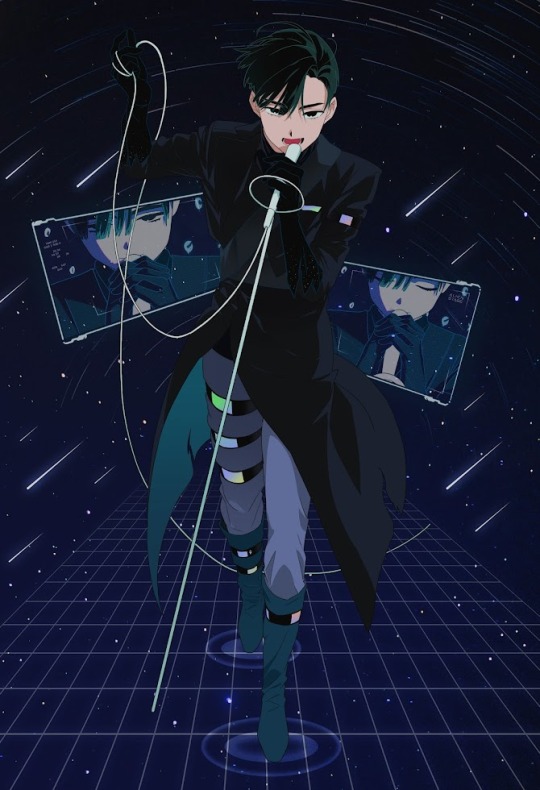
"I love angst. Ivan and Hyuna are my favorites from Alien Stage, and Black Sorrow was my third listened to song on Spotify Wrapped. He is a pining mess, but that's what makes him so appealing."
Protag | Elevator Hitch

"I like when he found a rat and tortured Coworker with it."
Orono | Gokurakugai

"He looks super fancy and super uptight, but then he opens his mouth (I'm assuming, I've never actually seen his face) and he says and does silly stuff. Like giving Alma a bunch of interrogation questions to ask but writing them down on a cutely decorated note. Amazing."
Experiment:
Reblog this post and add a poll of your own to the reblog. You can make it a poll about anything. Let's see how far it goes.
#other polls#poll#vein#link click#brett hand#inside job#the nowhere king#centaurworld#emil#nier#sakura haruka#haruka sakura#wind breaker#green mage#everhood#kou minamoto#toilet bound hanako kun#ivan#alien stage#protag#elevator hitch#orono#gokurakugai
5K notes
·
View notes
Text

I'm going a little insane over the symbolism in ROUND 3 of Alien Stage, so here's a (not-so) little visual analysis.
When I first watched this video, I was ecstatic, and not just because Ivan is my favorite. But I was also ecstatic to see once again the flowers that have been showing up very subtly throughout the series.
First, in the series theme, we see Till holding small red flowers behind his back. Then in ROUND 2, we see Till clutch them again, and then Till watch as Sua places a crown of red flowers upon Mizi's head. And then in ROUND 3, we see the flower crown itself, up close.
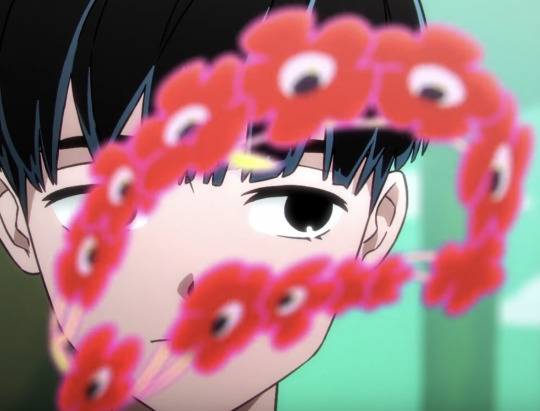
From what I can tell, these are either some kind of poppy, or maybe specifically poppy anemones/Anemone coronaria. I can't find any academic analysis for a common meaning, although the ever-unreliable flower meaning blogosphere associates them largely with forsaken love. But it doesn't really matter what the cultural meaning is, so much as the textual meaning.
Ivan's eyes are very clearly shown to be a visual inverse of these flowers. His eyes are black, deep black, and when his face is neutral we see no other color but black. But when he's experiencing intense emotion, we see that his irises are actually red!
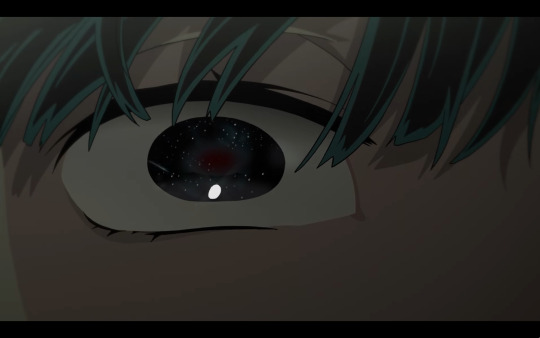
This happens first in the introduction, when he gazes at the stars (another heavily repeated piece of symbolism).
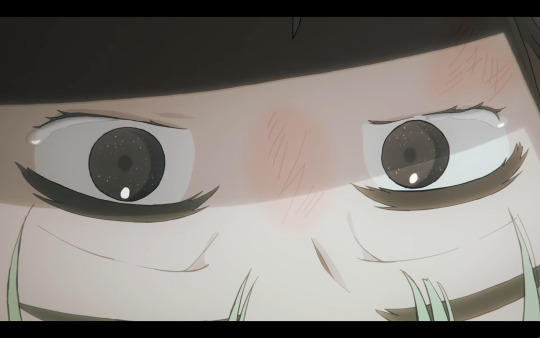
As he falls backwards, and the shadow of his former owner passes over him, his eyes become black once again, and remain black until he witnesses Till standing up against the creature with Mizi.


His iris swells red. Shooting stars flash across the sky, and in his eyes. As we cut back to his song in the present, his irises are still red. Stars shoot behind him now as he sings.
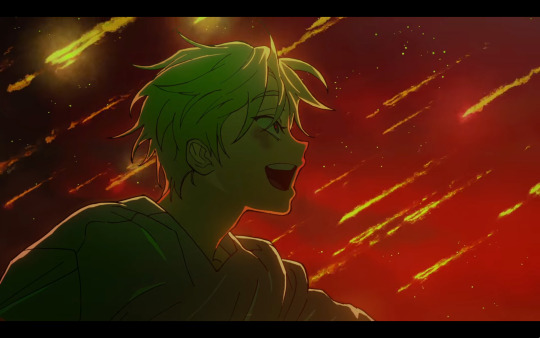
A flashback again, to Till. This time, the sky is warm, aflame; the glittering stars replaced by falling fire. Till's irises are also red now. But once Till turns back (presumably to go look for Mizi), his eyes return to their green color, and Ivan's become pure black once more.

Except in this last shot. This last shot, where, if you look closely, even beneath the shadows, you can see that his irises are once again inflamed with red.
The previous two songs mention flowers by name; clematis in ROUND 1, and edelweiss in ROUND 2. So I thought it strange that no flower appears within the lyrics of Ivan's song. Then I realized; a flower does appear in the lyrics, just not in the way you would expect!
At the end of this story There is only a cold spot stained with blood, and Such black, black sorrow
The flowers are red; stained with blood. They have a white ring in the middle; a cold spot. And their center is black; black sorrow. The same is true of Ivan's eyes; they reflect the coldness of space, except for the very center, a spot stained with blood, surrounded by black sorrow.
I wonder if we'll continue to see the flowers throughout the series, as they interconnect the relationships of Sua and Mizi, and Till and Ivan. Sua gives Mizi a flower crown as representative of her love. Till chases down and catches the flower crown as representative of his love for Mizi. And Ivan watches from afar, desire growing, as flowers bloom within his own eyes.
I've noticed also the repetition of red "eyes" throughout the series so far. First on the collars, which go from a bright green to red when locked. Then in the series theme, we see the red eyes of the soldiers. In ROUND 2, we see red lights around the stage, as well as in the security cameras in Till's room. Finally, in ROUND 3, we see red "eyes" several more times. Beyond Ivan, which I have already discussed, we see that his former master has red eyes. And, most importantly, we see them repeated throughout Ivan's flashback in which he fell in love with Till, and tried to escape with him.
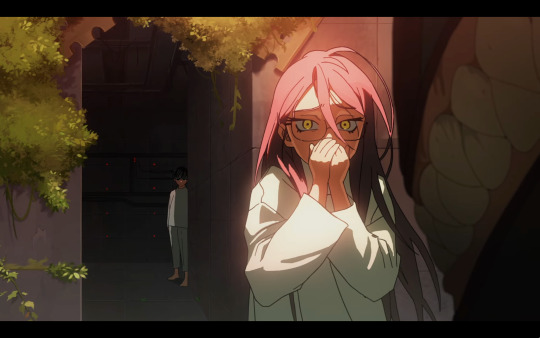

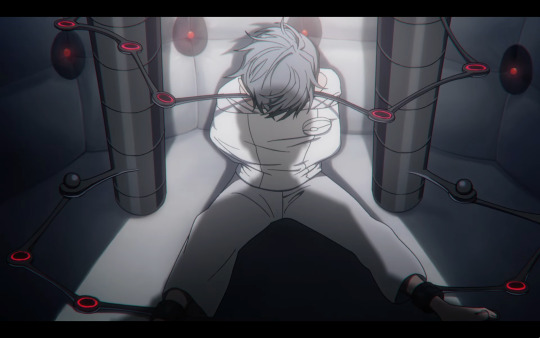
For Ivan, red represents his desire, and his love. But within Alien Stage, red is also representative of control and authority. Ivan loves Till, yes. But he also wants to control him, and to monopolize his affections. Which is why I am so, so thoroughly excited to see what a Till vs. Ivan round will look like in the future.
610 notes
·
View notes
Photo
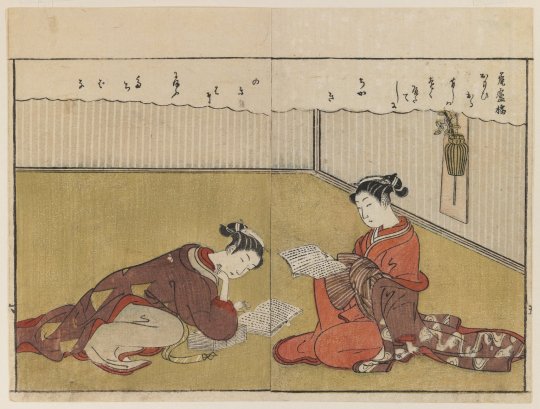
Closing out National Poetry Month, our Spring Interns paired some of their favorite poems with works from our collection. We hope you enjoy!
— Jeffrey Alexander Lopez, Curatorial Intern, American Art & Arts of the Americas
Image: Suzuki Harunobu (Japanese, 1724-1770). Page From Haru no Nishiki, 1771. Color woodblock print on paper. Brooklyn Museum, Gift of Peter P. Pessutti, 83.190.1
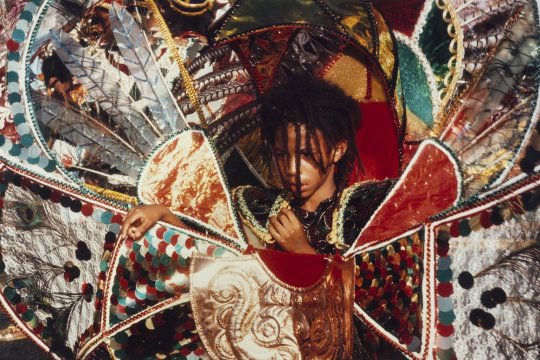
from Citizen: “Some years there exists a wanting to escape...” [Excerpt] By Claudia Rankine
/
I they he she we you turn only to discover the encounter
to be alien to this place.
Wait.
The patience is in the living. Time opens out to you.
The opening, between you and you, occupied, zoned for an encounter,
given the histories of you and you—
And always, who is this you?
The start of you, each day, a presence already—
Hey you—
/
— Halle Smith, Digital Collections Intern Catherine Green (American, born 1952). [Untitled] (West Indian Day Parade), 1991. Chromogenic photograph, sheet. Brooklyn Museum, Gift of the artist, 1991.58.2. © artist or artist's estate
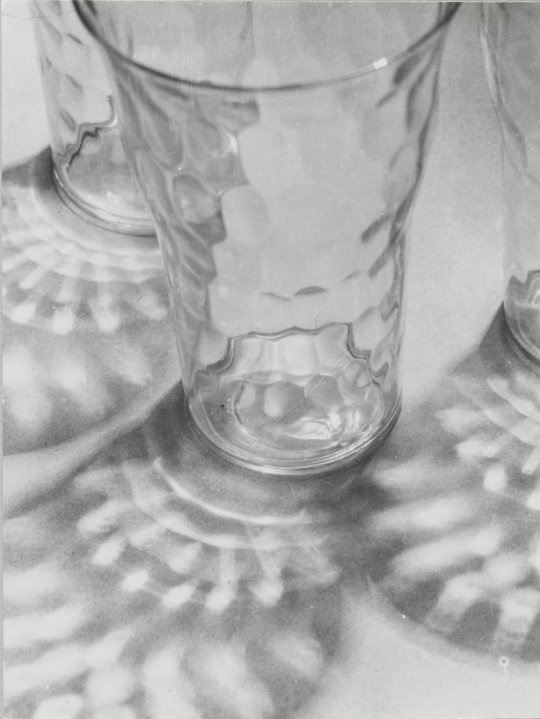
Ode to Enchanted Light by Pablo Neruda
Under the trees light has dropped from the top of the sky, light like a green latticework of branches, shining on every leaf, drifting down like clean white sand.
A cicada sends its sawing song high into the empty air.
The world is a glass overflowing with water.
Consuelo Kanaga’s black and white photograph captures a dazzling, yet fleeting moment from everyday life. Three textured glasses cast shadows whose patterns are almost kaleidoscopic in effect. We can imagine Kanaga passing by her kitchen table, as she is brought to a halt to take a closer look at, and ultimately to photograph, the simple beauty generated by the play of light and everyday objects. The close-up scale of this image emulates the singularizing framing techniques deployed by Surrealist photographers, who also took parts of everyday life and blew them up in the photographic frame, thereby encouraging their viewers to look at life around us from a different angle. It is a way of saying: Here, take a closer look. Viewing the world with wonder, along with the joy that this act brings, are encapsulated in Pablo Neruda’s poem Ode to Enchanted Light. The speaker observes the way light passes through trees and creates enchanting patterns. He not only observes, but feels the beauty in the simple details of life, from the way light falls from the sky, to the sheen of leaves, to the buzzing of cicadas. Approaching life through such a hopeful lens evokes a glass-half-full perspective. In fact, the speaker is so hopeful that he believes “The world is/a glass overflowing/with water.” I think Kanaga would have felt the same way.
— Kirk Testa, Curatorial Intern, Photography Consuelo Kanaga (American, 1894-1978). [Untitled] (Glasses and Reflections). Gelatin silver photograph. Brooklyn Museum, Gift of Wallace B. Putnam from the Estate of Consuelo Kanaga, 82.65.25
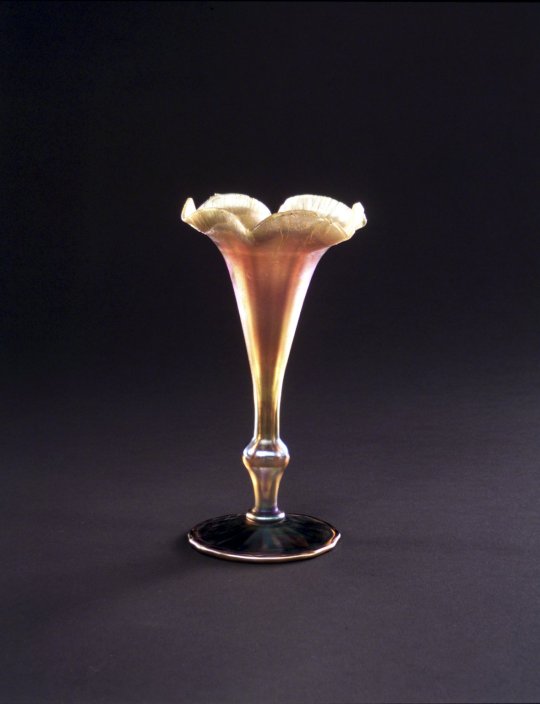
Easter Wings By George Herbert
Lord, who createdst man in wealth and store,
Though foolishly he lost the same,
Decaying more and more,
Till he became
Most poore:
With thee
O let me rise
As larks, harmoniously,
And sing this day thy victories:
Then shall the fall further the flight in me.
My tender age in sorrow did beginne
And still with sicknesses and shame.
Thou didst so punish sinne,
That I became
Most thinne.
With thee
Let me combine,
And feel thy victorie:
For, if I imp my wing on thine,
Affliction shall advance the flight in me.
Easter Wings by George Herbet and Martin Bach’s flower vase from the Brooklyn Museum’s Decorative Arts collection reveal the interrelationship between form and function. In Easter Wings, Herbert strategically varies the line length to create an image that enhances the meaning of the poem; when you turn the poem on its side, it resembles the wings of a bird, of which are symbolic of the atonement of Jesus Christ. In doing so, the author is not only telling us his message, but he is showing it visually as well. Similarly, the vase takes the visual form of its function. Its floral design amplifies the meaning of the object, as the vase is meant to hold flowers. In both instances, we see how aesthetic properties of a work echo the meaning and function of the work itself.
— Amy Zavecz Martin Bach (American, 1862-1921). Vase, ca. 1905. Opalescent glass. Brooklyn Museum, Gift of Mrs. Alfred Zoebisch, 59.143.16. Creative Commons-BY
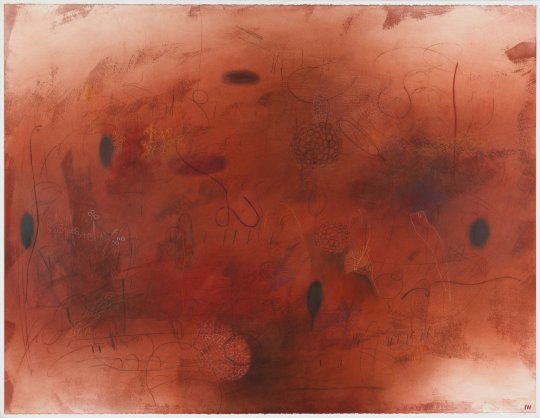
I am the Earth (Watashi wa chikyu) [Excerpt] by Kiyoko Nagase, Translated by Takako Lento
I am warm, moist soil I am a single supple stalk I draw my life all the way up into corollas of wild berries on the roadside
I am amazed at a breast of water welling to flow into the inlet of a muddy rice paddy I am amazed at myself being hot steam blowing fire and sulfur up from the bottom of the great ocean, deep indigo. I am amazed at the crimson blood flow covering the earth’s surface in human shape; I am amazed that it swells as the tides ebb and flow, and gushes out monthly under distant invisible gravity … I am the earth. I live there, and I am the very same earth.
In the four billionth year I have come to know the eternal cold moon, my other self, my hetero being, then, for the first time, I am amazed that I am warm mud.
The vivid imagery conjured up by Kiyoko Nagase’s poem is beautifully visualized by Emmi Whitehorse’s painting. The emphasis on deep Earth tones and abstract corporeality in both the poem and the painting really creates an intense metaphysical link between the environment and the self.
— Amanda Raquel Dorval, Archives Intern Emmi Whitehorse (Navajo, born 1957). Fire Weed, 1998. Chalk, graphite, pastel and oil on paper mounted on canvas. Brooklyn Museum, Gift of Hinrich Peiper and Dorothee Peiper-Riegraf in honor of Emmi Whitehorse, 2006.49. © artist or artist's estate
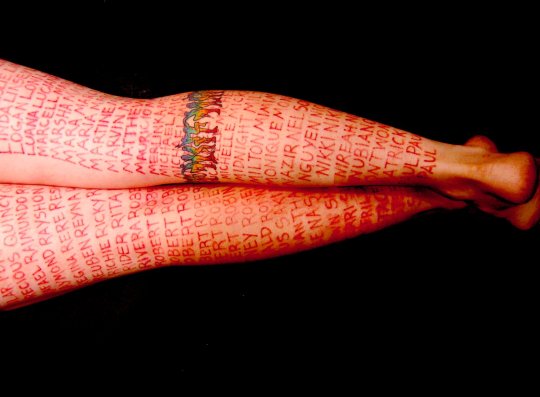
Seventh Circle of Earth by Ocean Vuong
On April 27, 2011, a gay couple, Michael Humphrey and Clayton Capshaw, was murdered by immolation in their home in Dallas, Texas.
Dallas Voice
1
2
3
4
5
6
7
________________________________________________________
As if my finger, / tracing your collarbone / behind closed doors, / was enough / to erase myself. To forget / we built this house knowing / it won’t last. How / does anyone stop / regret / without cutting / off his hands? / Another torch
streams through / the kitchen window, / another errant dove. / It’s funny. I always knew / I’d be warmest beside / my man. / But don’t laugh. Understand me / when I say I burn best / when crowned / with your scent: that earth-sweat / & Old Spice I seek out each night / the days
refuse me. / Our faces blackening / in the photographs along the wall. / Don’t laugh. Just tell me the story / again, / of the sparrows who flew from falling Rome, / their blazed wings. / How ruin nested inside each thimbled throat / & made it sing
until the notes threaded to this / smoke rising / from your nostrils. Speak— / until your voice is nothing / but the crackle / of charred
bones. But don’t laugh / when these walls collapse / & only sparks / not sparrows / fly out. / When they come / to sift through these cinders—& pluck my tongue, / this fisted rose, / charcoaled & choked / from your gone
mouth. / Each black petal / blasted / with what’s left / of our laughter. / Laughter ashed / to air / to honey to baby / darling, / look. Look how happy we are / to be no one / & still
American.
Ocean Vuong’s “Seventh Circle of Earth” has persisted as one of the great, affective moments of poetry in my life since I first heard Pádraig Ó Toama’s gorgeous reading and discussion of it on his podcast, Poetry Unbound. I decided to pair Vuong’s poem with Mary Coble’s Untitled 2 (from Note To Self) because both works are urgently immersive into the violence and experience of LGBTQ people in the U.S., and for how each work uses text and physicality to address presence, pain, and erasure. Vuong’s poem is actually footnoted to a quote from a news article about a gay couple murdered in Texas. The page is thus blank, absent of text. The reader has to sink below the main stage, the accepted space of word and story, to find the voices of this couple and the depth of their story’s tenderness, eroticism, and utter devastation. Coble’s piece foils the structure and effect of Seventh Circle of Earth by taking what was subverted by Vuong—text and the narrative of violence—wholly to the surface. Her photograph captures her own legs tattooed without ink with the names of LGBTQ individuals victimized by hate crimes. I cannot help but think of Franz Kafka’s short story “In the Penal Colony,” in which prisoners’ “sentences'' are inscribed by the needle of a “punishment apparatus” directly onto their bodies. I was struck by how the curator’s note for this photograph describes Coble’s artistic endeavor here as “harrowing.” The needle in Kafka’s short story is indeed called “The Harrow”. The noun harrow is an agricultural tool that combs plowed soil to break up clumps of earth and uproot weeds and clear imperfections. The verb to harrow means to plague, and in the story’s original German the verb for “harrow”, eggen, is also translated as “to torment”. Kafka and Coble conflate these definitions of “the harrow” in their respective works: they use a needled device, like the true noun definition, as an instrument of torment because of someone else’s idea of punishment and justice. Here, violence is brought to the surface, intimate in as much as we are brought right up to the artist’s skin and into the presence of her and her community’s pain. Together, one can see how each creator physicalizes their respective artistic space to tell the stories of LGBTQ people, of what is tender and harrowing, below the surface and written into the skin.
— Talia Abrahams, Provenance Intern, IHCPP Mary Coble (American, born 1978). Untitled 2 (from Note to Self), 2005. Inkjet print. Brooklyn Museum, Gift of the artist, 2008.10. © artist or artist's estate
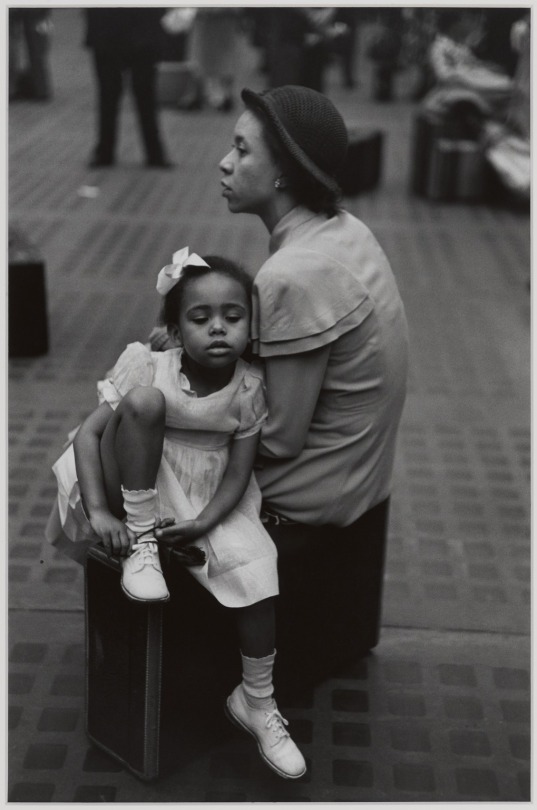
To my daughter Kakuya by Assata Shakur
I have shabby dreams for you of some vague freedom I have never known. Baby I don't want you hungry or thirsty or out in the cold. and I don't want the frost to kill your fruit before it ripens. I can see a sunny place Life exploding green. I can see your bright, bronze skin at ease with all the flowers and the centipedes. I can hear laughter, not grown from ridicule And words not prompted by ego or greed or jealousy. I see a world where hatred has been replaced by love. and ME replaced by WE And I can see a world replaced where you, building and exploring, strong and fulfilled, will understand. And go beyond my little shabby dreams.
This poem is featured in Assata Shakur’s memoir, Assata: An Autobiography. It details her hope for a better world that her daughter can grow up in. This poem is positioned in the book when Shakur is facing increasing prosecution as a result of her activism and affiliations with the Black Panther Party and Black Liberation army. Being written more than 30 years after this picture was taken, the poem summons me to think about the trauma that many Black women face and how much of that trauma gets passed down to their children. The black and white photo of a mother and daughter provides a nice visual to the poem. “The image of a Black mother and child sitting on their luggage reflects the little-discussed history of segregated transportation in the northern United States. Through the 1940s, Penn Station officials assigned Black travelers seats in Jim Crow cars on southbound trains” (Brooklyn Museum). The photograph of train passengers waiting outside of Manhattan’s Pennsylvania Station especially echoes the verse “I don’t want you hungry or thirsty or out in the cold.” The overall optimistic tone of Shakur’s poem alters our relationship to the image as we imagine the mother pictured above hoping for the exact same things
— Zaria W, Teen Programs intern Ruth Orkin (American, 1921-1985). Mother and Daughter at Penn Station, NYC, 1948. Gelatin silver photograph, sheet: 13 15/16 × 11 in. (35.4 × 27.9 cm). Brooklyn Museum, Gift of Mary Engel, 2011.22.3. © artist or artist's estate
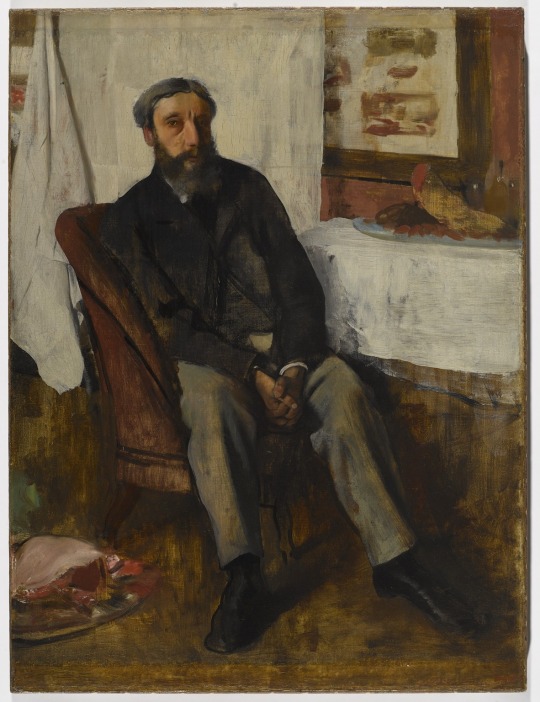
Crunch. By Kailyn Gibson
I retch as a mass of sinew lies between my lips. The sensation is unbearable. Fortunately, the jar of flies has gone missing again.
Slowly, surely, and yet never sure at all, the quiet of buzzing rings through the in-between.
It is a symphony wrought from blood and bone.
Saliva drips from bleeding, hungry gums, And the crunch of glass echoes the grinding of molars.
If I proffered a sanguine smile, would masticated shards look like teeth? Would they gleam just as prettily?
The flies ring, and the rot calls.
— Kailyn Gibson Edgar Degas (French, 1834-1917). Portrait of a Man (Portrait d'homme), ca. 1866. Oil on canvas. Brooklyn Museum, Museum Collection Fund, 21.112
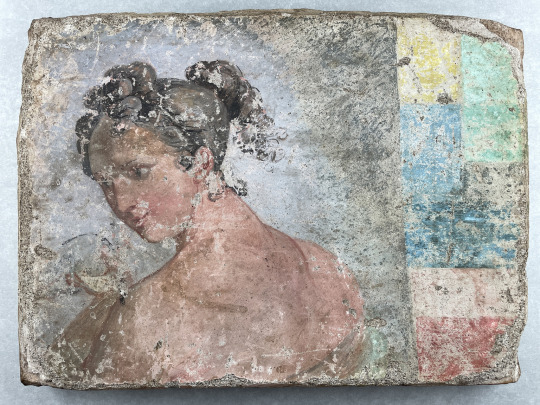
Excerpt from Autobiography of Red A novel in verse by Anne Carson
7. If Helen’s reasons arose out of some remark Stesichoros made either it was a strong remark about Helen’s sexual misconduct (not to say its unsavory aftermath the Fall of Troy) or it was not.
8. If it was a strong remark about Helen’s sexual misconduct (not to say its unsavory aftermath the Fall of Troy) either this remark was a lie or it was not.
9. If it was not a lie either we are now in reverse and by continuing to reason in this way we are likely to arrive back at the beginning of the question of the blinding of Stesichoros or we are not.
10. If we are now in reverse and by continuing to reason in this way are likely to arrive back at the beginning of the question of the blinding of Stesichoros either we will go along without incident or we will meet Stesichoros on our way back.
11. If we meet Stesichoros on our way back either we will keep quiet or we will look him in the eye and ask him what he thinks of Helen.
12. If we look Stesichoros in the eye and ask him what he thinks of Helen either he will tell the truth or he will lie.
13. If Stesichoros lies either we will know at once that he is lying or we will be fooled because now that we are in reverse the whole landscape looks inside out.
This excerpt comes from Appendix C of Anne Carson’s Autobiography of Red, a novel in verse. A translator and classicist herself, Carson mixes fact with fiction in her unconventional retelling of the myth of Geryon and Hercules, beginning with a roundabout introduction to the poet Stesichoros. Autobiography presents a captivating example of recent Queer projects that take up Classical material as their basis. A fascination with the Classical past has pervaded our modern conception of sexual identity politics, down to the very etymology of the word “lesbian.” In this fascination, I see the same desire to capture Classical imagery as cultural heritage which has also pervaded American museums, albeit with significantly different aims. The fresco pictured above comes to mind, which passed through many collectors and was even purchased by the museum before anyone pegged it as a modern piece—not an original Roman fresco. John D. Cooney, a 20th century curator of our Egyptian, Classical, and Ancient Near Eastern Art collection, wrote that “the unclad and somewhat winsome charms of the lady [probably] diverted objective glances.” Both in the case of the fresco and Carson’s novel, the “unclad and somewhat winsome charms” of the Classical past shape and reshape our understanding of history.
— Kira Houston, Curatorial Intern, Egyptian, Classical, and Ancient Near Eastern Art Modern, in the style of the Roman Period. Part of a Fresco, early 19th century C.E. Clay, paint. Brooklyn Museum, Ella C. Woodward Memorial Fund, 11.30.
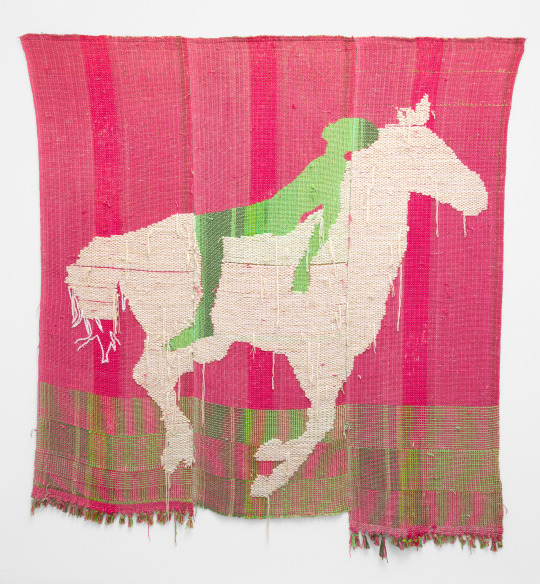
Late Fragment by Raymond Carver From A New Path to the Waterfall, Atlantic Monthly Press, 1989.
And did you get what you wanted from this life, even so? I did. And what did you want? To call myself beloved, to feel myself beloved on the earth.
— Shori Diedrick Brackens (American, born 1989). when no softness came, 2019. Cotton and acrylic yarn. Brooklyn Museum, Purchased with funds given by The LIFEWTR Fund at Frieze New York 2019, 2019.12. © artist or artist's estate
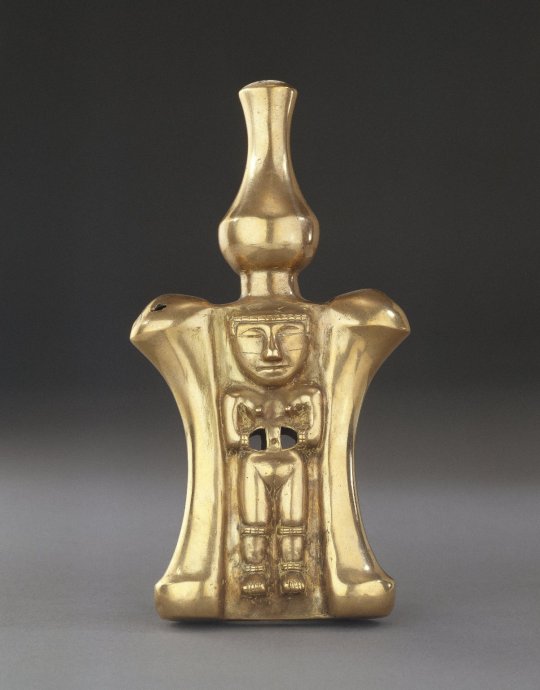
Jaguar By Francisco X. Alarcón
some say dicen que ahora I'm now almost estoy casi extinto extinct in this park por este parque but the people pero la gente who say this que dice esto don't know no sabe that by smelling que al oler the orchids las orquídeas in the trees en los árboles they're sensing están percibiendo the fragrance la fragancia of my chops de mis fauces that by hearing que al oír the rumblingc el retumbo of the waterfalls de los saltos
they're listening están escuchando to my ancestors' el gran rugido great roar de mis ancestros
that by observing que al observar the constellations las constelanciones of the night sky del firmamento
they're gazing están mirando at the star spots las motas de estrellas on my fur marcadas en mi piel that I am and que yo soy always will be y siempre seré the wild el indomable
untamed espíritu silvestre living spirit vivo de esta of this jungle jungla
While the author of the poem speaks about animals, their words can also speak on behalf of the erasure of indigenous peoples in South America. Much like the jaguar, indigenous traditions and culture are very important to life in South America. Despite their marginalization, Indigenous peoples throughout the Andes used coca leaves to help with the altitude. The use and cultivation of coca are criminalized throughout most of South America despite it being essential to indigenous cultures. This vessel was used to contain lime which would activate the coca leaves. Much like the jaguar, indigenous traditions are also faced with endangerment despite being woven into the fabric that is Latin America. Through the opposite man and woman figures, the vessel shows the duality that is important to the Quimbaya people which is still relevant to Colombians today.
Aunque el autor del poema habla sobre los animales, sus palabras también comunican el sentimiento común de la supresión de los indígenas en Suramérica. Con la mención del jaguar, se puede entender en el poema que la cultura y las tradiciones de las personas que son indígenas son sumamente importantes para la vida en Sudamérica. A pesar de su marginación, los indígenas en Los Andes utilizan la hoja de coca para ayudar en la altura de las montañas. El uso y el cultivo de la hoja de coca fue criminalizado (penalizado) a través de Sudamérica, aunque su uso para los indígenas era vital y esencial para su cultura. Este recipiente que se utiliza contiene limón lo que activa la hoja de la coca. Similarmente al jaguar, las tradiciones de los indígenas siempre estaban en peligro aunque estuvieran entrelazadas en las telas de lo que sería Latinoamérica. A través del hombre opuesto y las figuras de mujeres, el recipiente muestra la dualidad de lo que es importante para las personas que son Quimbaya, algo que todavía hoy es relevante para los Colombianos.
— Jeffrey Alexander Lopez, Curatorial Intern, American Art & Arts of the Americas Quimbaya. Poporo (Lime Container), 1-600 C.E. Tumbaga. Brooklyn Museum, Alfred W. Jenkins Fund, 35.507. Creative Commons-BY
116 notes
·
View notes
Text
Can I Be Him?
Title: Can I Be Him? Character(s) Mentioned: Bruce Banner, Tony Stark Pairing: Bruce Banner x Reader Genre: Romance Rating: E (Everyone) Words: 1,913 Author’s Note: Hello kitties and gentle-cats! Been a long time since I’ve updated, right? Again, I am sorry for that. It’s been really difficult to break through this writer’s block. However, I have managed to finish up this Bruce x Reader song-fic that I’ve had on my mind for a while now. I don’t know if it’s any good to be honest. It is shorter than my other stories, but I hope it will entertain you for a brief period. This is based on a song sung by James Arthur titled Can I Be Him?. He apparently won in the X Factor or another competition that Simon Cowell is part of, I don’t know. But you have heard his name but not the song, he is the same singer who sang Say You Won’t Let Go from his Back From The Edge album. It’s a beautiful song that many hopeless romantics can relate to. If you have an opportunity, definitely take a listen to it. Alright, on to the story! Presenting,Can I Be Him? Summary: Once again, Bruce Banner had found himself dragged into another one of Tony’s parties. He always found these pointless and dull since he never felt participating in random banters or discussions. However, this time became completely different. It could actually be worth coming, because you stepped into the door and into his heart.
Bruce Banner adjusted the white cotton collar of his shirt for the third time tonight as he attempted to keep himself far from the throng of people on the dance floor. He stood in the corner as he pondered to himself, Why did I agree to attend Tony’s party again? Oh, now I remember, I was forced to come. Though he didn’t mind socializing, Banner preferred to be away from the crowds. Maybe if Stark didn’t make this a black tie event, he’d might be more comfortable but tonight wasn’t the case. Tony had orchestrated this extravagant gala for a new charity he’s organizing, filled with many star studded celebrities, members of the Avengers, and some sponsors behind the organization along with him. Bruce already forgot what the charity was exactly for. Frankly, he always drowns out Tony’s incessant chattering.The physicist sighed deeply, debating if he should call it a night or not. Despite the reprimanding, he knew he would be receiving from his science partner, he took the chance and decided to make a run for it. Banner casually walked towards the bar, Tony leaned against it as he conversed confidently with one of his guests. “Tony, I’m gonna head out. It’s getting late.” Bruce lied, gesturing to the door over his shoulder. “What? The party’s just getting started. From what I recall, you don’t have a curfew, grandpa.” Stark quipped, crossing his arms in skepticism. He knew Banner well enough to know when he’s making excuses. “Well, not everyone can be as energetic as you, Tony.” Bruce replied, sarcastically. “Just—stay awhile longer,” raising his hands as a gesture to stop him from leaving before he went back to his guest. The physicist inwardly groaned before he nodded, accepting his suggestion. Now he knows, it was worth staying; the moment you walked into the ballroom. My heart has been stolen, Bruce thought to himself when he noticed your presence by the main entrance. You glowed with excitement as you gazed in wonder at the surroundings. It was nothing like you’ve ever seen before. The chandelier itself was eye catching, its crystal baubles shining brightly against the light. It felt like the atmosphere filled with your glow the moment you set foot into the festivities and Banner was captivated by you. It was as if your aura brought him back to the time he wasn’t living in a Dr. Jekyll and Mr. Hyde novel. He continued to watch you as you scanned the wide room, his senses heightening with a feeling he hasn’t felt in years. Bruce felt like the man he once knew, the man before the Hulk. As if on autopilot, he made his way towards you, like a gravitational pull he was unable to escape. You walked absent-mindedly, not paying attention to the strangers around you as you walked through the classical architecture of the museum that was rented for the evening. Suddenly, the high heel of your right foot caught the hem of your f/c mermaid gown, causing you to fall on your rear. You silently whimpered from the soreness slowly emerging beneath the skin of your behind. Your cheeks burned red from embarrassment, mentally hitting your forehead for your clumsiness.Thankfully, no one seemed to have noticed it. Well, you believed no one noticed. “Are you alright?” An older gentleman asked, offering his hand. You paused for a second, captured by the distinguished handsomeness of the person in front of you. You shook your head of such thoughts to answer him. “Yeah, just bruised my pride. Maybe even broke my butt bone, but I’ll live.” You answered with an awkward smile. You placed your hand in his, the warmth of his palm enveloping yours as he lifted you from the marble flooring. “I don’t think you broke your tail bone, but your pride, on the other hand…” “I’m Y/N. It’s nice to meet you, though I wish it wasn’t under these circumstances,” You introduced yourself as you laughed from his remark, not realizing you both continued to hold hands. “It’s nice to meet you, Y/N. Bruce Banner.” He replied back. You both looked down, noticing your hands were still joined. You two chuckled, embarrassed as your hands loosened their grip and fell to your sides. A faint blush rose to your cheeks, you bit your lower lip before you uttered another word. You weren’t too sure how he’d react to what you’re going to say. “I know who you are, Dr. Banner.” “Oh, you’re familiar with some of my work?” “Um…More like I’m familiar with you turning into a big green guy.” You stated with a worried grin. “I was there when you and the rest of the Avengers fought with those creepy alien…thingys.” Bruce chuckled, not surprised that the other guy would recognized before him. He’s come to terms with it, especially after he finally found the formula to keep his mind intact as he transformed. “Ah, that was my next guess. Love your elegant description, by the way. ‘Creepy alien…thingys.’” You became all that Bruce wanted. And he knew it from the very first moment. For the first time, Banner didn’t want the night to end. As long as he can spend it with you. “Excuse me, ladies and gentlemen. First of all, thanks for coming tonight. I know you probably had to call your babysitters, your nannies, or…whatever, to come tonight. I mean, it’s me so why wouldn’t you?” Tony smirked, holding the microphone close to his lips as his guests’ voices rose in laughter. “Now, I didn’t just invited you to bask in my glory. You guys do that everyday.” Once again, the crowd chuckled. Some clapped in amusement while Sam and a few other of his teammates teased him to get a move on. Bruce paid no attention to Stark on stage. He was more enthralled in what you were saying, making jokes and intrigued by his work. Granted, you had no clue what he was talking about but he made sound Science fascinating. The excited physicist was in the middle of explaining molecular energy when he blushed from raving over his field, pausing to look down at his shined dress shoes. “I don’t want to bore you with all this.” “No, no! I’m actually curious about what you do. Though I should warn you I’m not going to remember any of the terminology.” He slightly threw his head back in laughter. Banner hasn’t laughed this hard in ages. “So tell me, what do you do for a living? I’ve never seen you before.” “Oh well, I—” Stark’s voice drowned you when he announced, “Without further ado, presenting up and coming artist Y/N L/N!” A spotlight shined above as the applause of people boomed. You turned to the scientist, your cheeks turned rosier. “I’m the entertainment.” You nervously chuckled as you walked towards the stage, leaving Banner surprised and astonished but with his curiosity piqued. Your lips stretched into an earnest smile, taking the microphone from Tony’s hand before he walked off stage. “Thank you very much, Mr. Stark. Good evening, everyone. Um, I’ve written a song that is very dear to me. It came to me on a rainy Sunday morning. I hope you enjoy it.” A soft, gentle melody snuck in as your voice carried throughout the large space. Your song was a slow ballad, filled with the hope of finding your soulmate again. You sung of the constant pain of missing someone you’ve never met and how you send your love to them every night. Like a prayer, a lullaby that was only for your beloved and how you waited for their return. When Bruce heard that song, as if a light came on and began to flicker in his heart. Your heartfelt yet sorrowful song ended, the last note echoing before the crowd applauded your performance. Your e/c eyes turned to Bruce, a soft smile extending to your round cheeks. He looked back, completely mesmerized by you. He wanted to hear you sing again, allow himself to be captured by that melody that could almost break your heart as you waited for your love. However, he swore that every word you sang, you wrote it just for him. His thoughts, his woes, it was as if you felt it too. The whole room felt like it dissolved, leaving you and him alone. It was Bruce’s private show, though he knew you never knew him until tonight. As you stepped gingerly down the stairs, his eyes never left you. Bruce whispered to himself as you headed towards him, “Could I be the one you talk about in all your stories?… Can I be him?”
It’s two weeks since the gala ended. Bruce, in the lab with Tony, continued on with their work; however, his mind always went back to you and the sweetness of your voice. Besides you, the lyrics of your song haunted him. You both continued to speak after that evening, and created a bond like no other you’ve felt before. “So there’s this guy…,” You began, averting your eyes to the cup of coffee in your slender fingers as you sat on the cream leather couch near him. “Oh? I- I didn’t know you were seeing anyone.” Bruce stated, a tone of disappointment laced within his words. You made a face of uncertainty, your nose scrunching up causing the older gentleman to chuckle. Perhaps there was a chance? He doesn’t deserve you, Banner thought. His lips touched the rim of his paper coffee cup in order to hide his frown. “Frankly, it’s not serious. He’s hurt me so many times that I’ve cried more than I’ve smiled. I don’t know why I haven’t broken up with him yet.” You sighed, recalling all the times your significant other has broken a promise, lied, or just ignored your presence for something of “more importance”. If you were mine, I’d never let anyone hurt you, Y/N. I wanna dry those tears, kiss those lips… It’s all I’ve been thinking about. He said internally what he couldn’t say out loud. However, the moment he noticed your eyes welling up with tears; your face clearly displaying sadness and frustration, he couldn’t hold his words back any longer. “Leave him.” You turned to him in surprise, “What?” “Leave him, Y/N. Be with me. ‘Cause a light came on when I heard your song and I want you to sing it again. I swear that every word you sang that night, you wrote them for me. I know it sounds ridiculous, but it’s true. Everything disappeared and it was like a private show, even though you weren’t singing it for me,” He said, nervously chuckling at what was spilling out of his mouth and heart. Bruce knew that he’s going out on a limb here, declaring his feelings to someone he’s only known for a few short months but he knew that this connection wasn’t one-sided. You must have felt it too. “Bruce…,” You whispered, a soft grin emerging as the tears rolled down your cheeks. “Can I be the one you talk about in all of your stories?” Banner moved closer to you, closing the small gap of cushion. His large and rugged hand reached out for your cheek, which you leaned in without hesitation. “Can I be him, Y/N?” You brushed your soft pink lips against his, your e/c eyes never closing as you met his deep coffee brown ones. “…Yes.”
#Bruce Banner#Bruce Banner Fanfiction#The Hulk#The Hulk Fanfiction#Marvel#Marvel Fanfiction#MCU#MCU Fanfiction#Marvel Cinematic Universe#Marvel Cinematic Universe Fanfiction#The Incredible Hulk#Fanfiction#Marvel Comics#Avengers#The Avengers#Avengers Fanfiction#Bruce Banner x Reader#Reader Fanfiction#Reader Insert Fanfiction#Bruce Banner x Y/N#Y/N#Y/N Fanfiction#Y/N Insert Fanfiction#Reader Insert#x Reader#x Y/N#The Hulk x Reader#The Hulk x Y/N#Avengers x Reader#Avengers x Y/N
149 notes
·
View notes
Note
All the odd numbies
1:A song you like with a color in the title
3:A song that reminds you of summertime
youtube
7:A song to drive to
this isn't just because it has a driving themed name okay (see also: chasing cars)
11:A song that you never get tired of
13:One of your favorite 80’s songs
i would've chosen an upbeat song but THIS MOVIE!!!!
15:A song that is a cover by another artist
my 2 favorite aishite aishite aishite covers
17:A song that would sing a duet with on karaoke
youtube
see also: oh my clematis, sweet dream, cure, ruler of my heart (if i could actually sing & if i knew a little bit of korean)
19:A song that makes you think about life
youtube
you know what this song made me think about? the fact that I've always assumed it was by mafumafu. no. the mafumafu version is a cover. im still linking it tho cuz i like it
21:A favorite song with a person’s name in the title
25:A song by an artist no longer living
youtube
27:A song that breaks your heart
youtube
ty for the ask :3
1 note
·
View note
Text
Footsteps: Chasing the Spirit of a Fractured Spain Through García Lorca
New Post has been published on http://usnewsaggregator.com/footsteps-chasing-the-spirit-of-a-fractured-spain-through-garcia-lorca/
Footsteps: Chasing the Spirit of a Fractured Spain Through García Lorca
To search for García Lorca’s Andalusia is to chase fragments of poetry and loss. He was silenced more than 81 years ago at 38 — murdered in the summer of 1936 by a paramilitary death squad at the outset of the Spanish Civil War for his anti-fascist sentiments and homosexuality. His burial site in an anonymous mass grave somewhere in fields outside Granada remains a mystery.
Continue reading the main story
But his powerful voice is still one that binds this nation as it struggles with tensions between the Catalan independence movement and the Spanish state, which threatened to remove the region’s separatist government and initiate a process of direct rule by the central government in Madrid.
In August, the poet’s verses offered a measure of comfort after the deadly van attack along the Ramblas, the heart of Barcelona. Over booming loudspeakers, thousands of antiterrorism protesters listened to a recital of García Lorca’s tribute to his favorite thoroughfare: “The street where all four seasons live together. The only street I wish would never end.”
Photo
Restaurant on Street Market in Granada. Credit Javier Luengo for The New York Times
When he was 18, he set off from Granada in 1917 on the first of four expeditions by steam train with his art history professor and other students to tour Andalusia. It was then, he said, that “I became fully aware of myself as a Spaniard.” He was seeking memories of “the ancient souls who once walked the solitary squares we now tread.”
My love of García Lorca extends to all his writing that explores the rural tragedies of women in Andalusia and an earthy culture where death and love are deeply intertwined. I had never expected to visit his house in Granada, where the poet wrote his trilogy of greatest plays — “Blood Wedding,” “Yerma,” and “The House of Bernarda Alba.”
But a reporting assignment took me to the city one day, and I met his niece, Laura García Lorca, in his family home, Huerta de San Vicente, now a museum and whitewashed sanctuary, which is surrounded by linden trees and roses.
The downstairs living room was dark and smelled faintly of jasmine. It was furnished with black and white photos from many decades ago, along with García Lorca’s baby grand piano and a pensive portrait of the writer, with dark wavy hair and sharp eyes, wearing a mustard robe.
Photo
Tapa de Caracoles con Jamon at Chikito Restaurant. Credit Javier Luengo for The New York Times
His niece led me upstairs to his bedroom and study, furnished with a single bed and an oak desk stained with ink. And there we paused, the memories in this silent house so profound that her tears still flow. “The story is very present,” she said. “We share this as our loss.”
It was soon after that I decided to chase the spirit of this fractured nation through García Lorca’s literary inspirations in southern Spain. I began my first journey with a 10-day road trip with my husband, Omer, through Andalusia in a rented Fiat, hurtling on a smooth stretch of highway through golden hills and olive groves and white villages and ancient Arab fortresses.
Continue reading the main story
We toured Granada, the poet’s hometown, where liberal and conservative political divisions still simmer in a lingering fight over control of García Lorca’s vast archives. In the meantime, the literary treasure has not yet moved from Madrid to a soaring new cultural center built to house it. But public authorities and the writer’s family are close to settling their differences and the archives are expected to arrive within months at the center by the tranquil Plaza de Romanillo.
Before his death, García Lorca alienated the local society by complaining that Granada was inhabited by a cold, introverted ruling class. Yet, despite the mutual loathing, he held court here in the 1920s with his young literary circle of intellectuals, “El Rinconcillo.” At a restaurant known then as Cafe Alameda, he would read his works aloud from the same corner table.
Photo
Ruins of Cortijo de Fraile in Almería, Spain. Credit Javier Luengo for The New York Times
Today his refuge is named Chikito, and the restaurant’s cuisine is typically Andalusian with a popular tapa of tiny snails with ham and almond sauce and its specialty, an oxtail stew. In 2015, the writer’s favorite corner was transformed into a shrine with a life-size bronze statue of García Lorca seated at a vintage marble table in a dapper bow tie.
The most touching tribute, though, is spontaneous — an annual midnight-to-dawn flamenco tribute every Aug. 19 on the anniversary of García Lorca’s death that is an open secret among performers and locals.
It takes place in the hills northeast of Granada in El Barranco de Viznar but it received little public attention on the 80th anniversary of his death a year ago near the likely mass graves.
In the balmy darkness, trembling voices rose from the forest to the sound of cante jondo or deep song — music that inspired the poetry of García Lorca, who was a musician himself. He likened its rhythms and wavering stammers to the trilling of birds and the music of forest and fountain. And he believed it had to be preserved because it represented the ancient music of the persecuted and oppressed of Andalusia — Arabs, Jews and Gypsies — who fled into the mountains in the 15th century to escape the Spanish Inquisition.
Photo
The oldest Triana or Isabel II bridge, rebuilt by engineers for Gustave Eiffel. Credit Javier Luengo for The New York Times
For the writer, other cities like Seville offered more openness and tolerance — something he considered a reflection of physical geography and the Guadalquivir River that flows within the city and outward to the Atlantic Ocean, shooting through, he wrote in a poem, like “a constant arrow.”
We traveled to Seville, where we sampled a boat trip along the olive-colored Guadalquivir for about a $20 ticket. But the hourlong ride seemed more languid than García Lorca’s dynamic description and the riverside more neglected. The highlights on the trip centered on passing under bridges, the oldest Triana or Isabel II rebuilt by engineers for Gustave Eiffel.
Continue reading the main story
Instead we found more of the city’s essential soul or spirit of “duende” in the sprawling San Fernando municipal cemetery. At its entrance is an exotic neighborhood of tombs and shrines devoted to the city’s Andalusian aristocracy — flamenco stars and fallen bullfighters such as Francisco Rivera Pérez “Paquirri,” who is sculpted in a matador’s suit and poised to guide a bull’s final attack.
It was in Seville that García Lorca befriended Ignacio Sánchez Mejías, a bullfighter who was also a poet and a playwright. After Ignacio was gored in a post-retirement bullfight in 1934, García Lorca wrote his classic elegy in tribute to him, a 1935 poem of disbelief and grief about his death at 43.
Photo
Nijar Cemetery. Credit Javier Luengo for The New York Times
There is no more affecting place to read aloud his lament — “Oh white wall of Spain! Oh black bull of sorrow! Oh hard blood of Ignacio!” — than beside the matador’s simple grave. It lies in the shadow of an enormous tomb for his fellow bullfighter and brother-in-law, Joselito, who was killed in 1920 by a bull named Bailaor. That marble and bronze sculpture depicts Joselito in his draped coffin, shouldered by 18 distraught men and women. One of the figures is Ignacio, head cast to beseech the cloudless skies.
Death, honor and frustration are themes that endlessly fascinated García Lorca. In 1933, he staged the premier of “Blood Wedding” in Madrid, drawing on 1928 newspaper accounts of a defiant bride, Francisca Cañadas, who abandoned her fiancé — her sister’s brother-in-law — to flee hours before a pending marriage deep into the countryside with her beloved first cousin.
Her sister and her husband tracked them down, fatally shooting the cousin and strangling Francisca, leaving her for dead on the road to Nijar. The bride survived, living for decades with the enmity of her village who blamed her for provoking the tragedy.
In his drama, García Lorca transformed the key characters and heightened the bloodshed. He conceived of the set inside a spacious cave like the ancient enclaves in Purullena and Guadix, southern towns in the province of Granada known for mazes of whitewashed caves fashioned into homes and with inhabitants called trogloditas. He was struck by the rare accommodation of life and earth in the labyrinth of cave dwellings — some that date back to the 16th century.
Photo
Purullena village and the caves in Granada, Spain. Credit Javier Luengo for The New York Times
We had stayed a few years earlier in a rented cave in Purullena, which is also known for its cobalt blue ceramics made with a special polychrome technique that dates to the 16th century. The cave was a cool refuge on hot August nights and so profoundly silent that sleep transformed to nights of intensely vivid dreams. On this trip, we returned again to explore the caves in Guadix and Purullena, some thoroughly modern with wrought iron guard gates, chimneys, marble floors, Wi-Fi access and television antennas poking out of the oatmeal colored hills. Others were gothic ruins from past centuries, poetry in white against the blue splendor of skies.
On a back road in a cave neighborhood in Purullena, a silver haired woman in a black coat and cane noticed us photographing the homes. She beckoned us inside her cave with a red tiled awning and arched door.
Continue reading the main story
Her kindness reminded me of another basic element of Andalusia that García Lorca cherished — its people. On the same day that she spoke to us, we stopped nearby in Graena, a small town that is home to spring-fed thermal baths and an outdoor barbecue restaurant, Bar La Pradera, which specializes in lamb chops and steak grilled on hot coals. We had not dined there in five years, and tourists rarely stop there, at the terrace across from an open-air municipal pool and garden. But the owners welcomed us back with kisses and then they invited us to their home.
No journey like this could be complete without witnessing the last act of “Blood Wedding.” We rumbled along a dirt road to reach the Cortijo del Fraile, the crumbling farmhouse where Francisca Cañadas lived with her father who owned the property then. Today, it is a surreal landmark of ruin and romance in Europe’s only semidesert, the Cabo de Gata Nature Preserve in Almería, Spain’s southeastern corner.
The fragile farmhouse is surrounded by a wire fence to prevent entry of tourists. Its facade has been minimally restored but there is much more work to be done. A plain marker took note of its literary pedigree — and also its star turn as a backdrop in various movies, among them, Sergio Leone’s spaghetti western “The Good, the Bad, and the Ugly.”
El Cortijo del Fraile en El Bueno, El Feo y El Malo (El Rubio y Tuco) Video by José Manuel Hita Segura
From the ruins, we headed toward the town of Nijar and stopped at one of its oldest municipal cemeteries. Its white walls were full with rose and blue silk flowers and tribute plaques to the village’s dead, including members of the star-crossed Cañadas family.
Every time I visit Andalusia, I try to find some trace of the grave of the runaway bride. She never married and was essentially buried in life by the scorn of her village. And every year nothing changes in the essential rural tragedy imagined by García Lorca.
A lone cemetery worker offered me a vague hint that Francisca Cañadas’s tomb is placed near a soaring cypress tree, a symbol of mourning and hope. But a stone plaque was nowhere to be found. According to the family’s wishes, the worker said, it is marked with a false name.
Continue reading the main story
Original Article:
Click here
0 notes
Text
Little Shop of Horrors: Gender, Race, Genre Formatted from the original script I utilized for a video essay
At times, the Musical genre and necessity of its component parts do damage to the narrative through long musical interludes that appear to literally lose the plot for minutes at a time. So easily then, is the act of changing characters into caricatures, little avatars aspiring to be part of a larger and more cohesive film. Thus, one can discern the disregard the Film Industry as a whole appears to possess towards the Musical genre; an interesting escapade with little dots of worth sprinkled amongst childish attempts at narrative. While this stance appears fairly consistent in critical circles, it is an underhanded and weak avenue for which works such as Little Shop of Horrors (1986) and La La Land (2016) to name a few, scoff amidst their bounty of thematic value. Musicals utilize their tools to embolden the emotion and persona onscreen as director Edgar Wright stated in a 2010 interview with /SlashFilm regarding his then in development film, Scott Pilgrim VS. The World, “We thought it should play out like a musical in a way in terms of the fights are not dissimilar to the songs. I always thought there were a lot of martial arts films that were like musicals, so we wanted to take that further. Ya know, in a Gene Kelly film when he performs an amazing routine, at the end of the scene no one goes, ‘Oh my god, that was fucking amazing!’ The song is about something, and then there might be some dialogue at the end that is also about that theme. And that’s kind of how this works where people have these huge fights – and it’s kind of like how it is in the books – where everything goes back to normal, and there’s a little reaction to what just happened…” Wright’s summation of the genres dependency upon bursts of emotion contained to exclusive events, or more aptly put, songs, highlights the reason well-directed musicals possess just as much artistic merit as their counterparts outside the genre. However, emotion is not always the key ingredient in the boiling point that sets off a musical number as is evident in Frank Oz’s Little Shop of Horrors (1986) Rather, any number of thematic undertones can possess the narrative and induce the inner machinations of directorial intent to spur musical pieces with messages pertaining to, in this case, politics. Utilizing themes relevant to the era of release, and that of its Roger Corman original, Little Shop is a musical that portrays Racial tensions, Class, Heteronormativity,, the War on Drugs, Nixionisim, and the American Dream, through a musical lens which tells the tale of outlandish killer space plants subtly invading earth. Through catchy tracks and visual stimuli, Little Shop of Horrors tendrils pried its way into the public consciousness under the pretense of a genre flick, only to, much like Audrey II, unfurl into something much larger than originally anticipated, “And this terrifying enemy surfaced- as such enemies often do- in the seemingly most innocent and unlikely of places”(LSH)
The lineage of the work is a well storied revisiting and altering of the source material. The most arguably “famous” version of the work being 1986s aforementioned Little Shop of Horrors, directed by Frank OZ, a screen adaptation of the Off Broadway 1982 play of the same name. The play itself, however, was adapted from the original 1960 Roger Corman low-budget classic, The Little Shop of Horrors which itself is thought to conceptually based upon the 1932 short story, Green Thoughts, written by Jon Collier. The narrative of Little Shop of Horrors takes place at the same time as its 1960 predecessor and is set in the same decade. JFK is president and as the opening crawl tells the viewer, “On the twenty-third day of the month of September, in a year not too long before our own” (LSH) which would evidently mean it takes places somewhere between 1961 to 1963 as JFK’s assassination was not until November of 63. The reasoning for which this is important falls upon the thematic underlying of the film, namely that of issues between Black integration into White society. The 1960s were a hotbed for social upheaval, between the Vietnam War, Civil Rights Protests, assassinations of Martin Luther King and John F Kennedy, the Cuban Missile Crisis, and landing on the Moon; the world was rapidly undergoing massive change at an unprecedented rate. A hotbed setting regarding aliens subtly invading earth further played host to national distrust of authority which was further stoked by the fallout from Richard Nixon’s presidential term in office, resulting in a more cynical America than previously encountered. The original stage production’s creators, Alan Menken and Howard Ashman, understanding the political landscape of the two eras’s manipulated the original plot of The Little Shop of Horrors to service the needs of the American people, criticizing core values like the American Dream and the moral cost of pursuing it.
Utilizing the tools inherent within the genre, through the use of pastiche, the film conveys it’s characters personalities, setting immediate expectations for the unfolding narrative. The threesome interacting directly with the audience are an evident parody/reference the Moirai, or as they are known today, the Fates. White-robed fragments of Destiny, they were denoted by their actions, the Spinner, the Allotter, and the Unturnable. In Little Shop, they exist outside of the narrative, observers of a pivotal event in the course of the universe, as the weavers of Destiny, controlling the “metaphorical thread of life of every mortal from birth to death” (WIKI) While they themselves never appear to have this kind of agency in the narrative, their musical interludes, which themselves resemble a gospel choir, only appear at important points in the story. They are present so as to continue weaving the image of their whole. Audrey, high pitched and stereotypically feminine, literally wishing for nothing more than to be a housewife as seen in the playfully nihilistic “somewhere Green”, is represented by pretty woodwind instruments and chimes, gentle and optimistic music which conveys her nature and fragility. Seymour himself begins as a character represented by clumsy and mournfully sorrow representation with songs like “Grow for Me” which has playful charm and wit but is clearly about Seymour’s failure to convince his newfound plant life to grow. When, finally, it responds to him, he bemoans the circumstance as the only sustenance the plant, who is to become known as Audrey II, desires are human blood. When, finally, Seymour surrenders to the plant begins to feed it, his musical numbers warp and shift, becoming more flavourful and R&B inspired. With his musical voice shifting to a more ‘Urban’ style, to better suit Audrey II’s own voice, he becomes characterized as the other the further his own style shifts. Further reinforcing stereotypical views of urban lifestyles, this shift occurs as Seymour begins to act outside of the rules of society in order to continue his pursuit of fame. Audrey II itself is classified as the other through its visual style but also the stylistic choices that carry Seymour along with it, R&B. Audrey II, voiced by Levi Stubbs, lead singer of R&B group Four Tops, is clearly ethnicized as black. Vocal language, as well as evident musical style, denotes this and with this in mind, it is the “monster” that corrupts the genuine and wholesome Seymour. As Audrey II is racialized to fit into a specific ethnography, it appears that traditionally black music is a threat to the white standard of living and is to be feared.
Seymour’s journey to stardom through the public’s sudden obsession with Audrey II stems from the same healthy disdain the creators of the stage production held in regards to the path towards the American Dream which parallels the Nixon presidency, relevant at the time of the film's release as his time in office was completed barely a decade prior and the American people were still reeling from his term as president. The journey to greatness for both Seymour and Nixon were, as the quote goes, “paved with good intentions” however ultimately both led to corruption and ethical degradation of character. As Seymour pinned for the love of Audrey, Nixon attempted much the same with his country, attempting to rig his way to success. Both wanted more than was given to them and through the struggle to attain it, lost themselves in the process. This is what the two creators of the original stage production meant when they alluded to the American Dream being a worthy venture, as it is, however, as they themselves noted, it’s the journey that damns the soul, not the prize at the end of the road. The temptation to continue down the path to the desired goal is strongly presented in the narrative by the musical interludes which lend story-progression and thematic scoring to the academic context of the film. “Grow for Me” represents the beginning of this journey, a difficult first step onto a larger path which takes some time and accustomization to adapt to. Yet, before long, it begins to feel as though turning back no longer feels like an option as displayed by the song “Feed me (git it)”. However, when it actually is too late, “Meek Shall Inherit”, “Mean Green Mother”, and “Don’t Feed the Plants” there is nothing to be done but look back mournfully in hindsight, just as the U.S did post-Cambodian bombing and Watergate Scandal.
The musical piece “Skid Row” speaks at great length to both the realities and stereotypical depictions of living “downtown”. Everyone involved in the number is looking for a way out as is evident with quotes like “I’d move Heaven and Hell to get out of here” and “ I don’t know what I’d do to get out of here” downtown is painted as a horrific place to live but it’s also a place of great diversity. There are far more people of colour present in this number than whites and still, they don’t have the platform to speak to the further woes of living on skid row as the two white leads are the focus of attention. It’s not until Audrey II is nearly full grown that the shift begins to move from the white protagonists and over to the “other” That said, the three Do-op girls have a number to themselves prior to this, at the beginning of the film in the prologue “Little Shop of Horrors” yet as they function as an in-universe representation of the Fates as previously mentioned, no attention is paid to them as they are effectively invisible, just like minority representation in these communities. Unheard from until their voices become a loud roar, no longer able to be silenced.
Little Shop of Horrors is a momentous work which further validates the artistic legitimacy of the musical genre. With a nearly endless amount of respect for its viewing audience, the film is genuinely intelligent and navigates its own themes with grace. Immensely rewatchable and catchy, it easily crawls its way into the brain and stirs one’s mind. Subtly at first, until, all at once, the connections to larger themes become startlingly relevant to the viewer. At first glance, perhaps, a film about a giant singing plant appears like a fun shlock filled adventure. Meaningless in its content but properly constructed to kill a few hours of time. Which is why this iteration works so well, it leads to such a promise but, much like Seymour in the original cut of the film, it pulls one along until, suddenly, you are consumed.
#little shop of horrors#shop#musical#film#queen's university#video essay#script#essay#thought#process#music#space#alien#70s#nixon#race#gender
0 notes